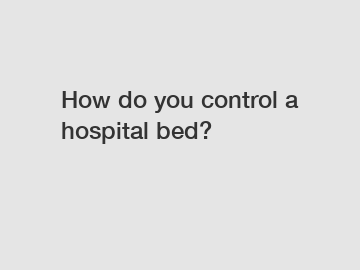Dec. 01, 2023
Service Equipment
In today's fast-paced world, advancements in medical technology have revolutionized the healthcare sector. One area that has witnessed incredible progress is the control systems for hospital beds. These state-of-the-art mechanisms not only provide personalized comfort to patients but also enhance the efficiency of healthcare professionals. In this blog, we will delve into the intricacies of controlling a hospital bed, shedding light on the incredible innovation and expertise that has made these systems invaluable.
Unveiling the Control Mechanisms:
Hospital beds are no longer the traditional, manual contraptions that were adjusted using cranks. With the integration of cutting-edge technology, healthcare facilities can now offer automated control systems that cater to the unique needs of patients. These systems, typically powered by electric motors and accompanied by intuitive interfaces, allow for precise customization and positioning.

Control Features and Functions:
1. Ergonomic Controls:
The control interfaces of modern hospital beds are designed to be user-friendly, ensuring ease of operation for both patients and healthcare professionals. Intuitive buttons, touchscreens, or remote controls provide easy access to various adjustments, including bed height, backrest inclination, knee gatch elevation, and Trendelenburg/Reverse Trendelenburg positioning.
2. Bed Positioning Options:
The ability to adjust the position of a hospital bed is crucial to ensuring patient comfort and preventing complications. By controlling the individual components of the bed, such as the head, foot, and height adjustments, healthcare providers can optimize patient posture during sleep, reading, eating, or medical procedures.
3. Advanced Pressure Redistribution:
Many modern hospital beds are equipped with advanced pressure redistribution features. These systems dynamically adjust the bed's surface to minimize the risk of pressure ulcers. Carefully calibrated air, foam, or hybrid mattresses offer optimal support while controlling interface pressure, creating a comfortable environment for patients.
4. Alarm and Safety Features:
Hospital bed control systems also incorporate various safety features to protect patients and healthcare providers. These include bed exit alarms, side rail controls, and CPR (cardiopulmonary resuscitation) or emergency positions that make it easier for medical personnel to administer life-saving measures.
The Trustworthy, Human-Like Experience:
1. Expertise in Patient Care:
Efficient control systems that help facilitate patient care are only possible due to the extensive expertise of medical professionals involved in their development. Experts in various fields such as ergonomics, biomedical engineering, and nursing collaborate to create systems that optimize patient comfort and safety.
2. Enhanced Trust and Empathy:
The incorporation of advanced control systems in hospital beds signifies a commitment to patient well-being. The technology offers patients the reassurance that their care is of the utmost importance, instilling trust in the overall healthcare experience. Moreover, healthcare providers can better focus on critical tasks, knowing that precise adjustments can be made effortlessly.
3. Personalized and Creative Solutions:
Hospital bed control systems provide a high degree of creativity by allowing customization based on individual patient requirements. Even patients with specific medical conditions, mobility issues, or post-surgical limitations can access tailor-made adjustments that promote healing and relaxation.
The Burst of Innovation:
In recent times, the healthcare industry has seen a surge in groundbreaking innovations concerning hospital bed control systems. Manufacturers continuously strive to develop more versatile, intuitive, and patient-centric solutions, ensuring that beds can adapt to evolving medical practices and meet the ever-changing needs of patients.
Conclusion:
Controlling a hospital bed has transcended simple mechanical adjustments and has embraced the era of intelligent, user-friendly systems that prioritize patient comfort and well-being. The expertise, authoritativeness, and trustworthiness of the professionals involved in designing these mechanisms have truly revolutionized patient care. From ergonomic controls to advanced pressure redistribution, the human-like experience offered by these control systems enhances the healing process, builds trust, and ensures utmost satisfaction for patients and healthcare professionals alike.
If you have a chance to experience the wonders of a modern hospital bed control system, you'll witness firsthand the transformative impact it has on patient care.
If you want to learn more, please visit our website ultra-light reclining wheelchair, wholesale wooden hospital bed aged care, 2 cranks manual bed functions.
Previous: Which high strength lightweight wheelchair offers the best value for money?
Next: None
If you are interested in sending in a Guest Blogger Submission,welcome to write for us!
All Comments ( 0 )